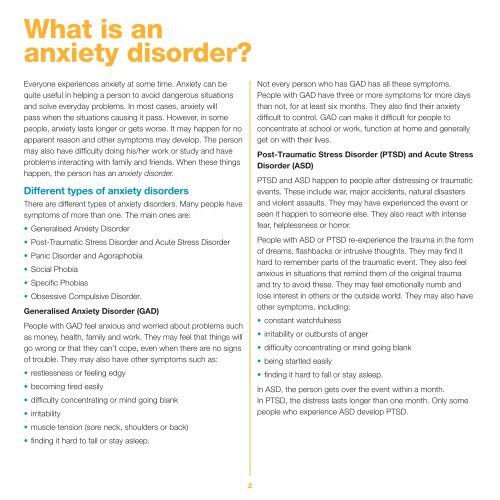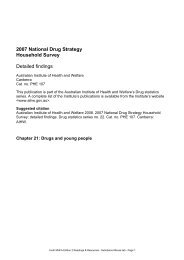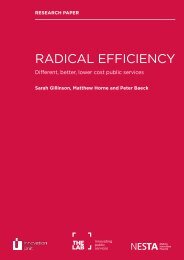A Guide To What Works For Anxiety Disorders - Mental Health First Aid
A Guide To What Works For Anxiety Disorders - Mental Health First Aid
A Guide To What Works For Anxiety Disorders - Mental Health First Aid
Create successful ePaper yourself
Turn your PDF publications into a flip-book with our unique Google optimized e-Paper software.
<strong>What</strong> is ananxiety disorder?Everyone experiences anxiety at some time. <strong>Anxiety</strong> can bequite useful in helping a person to avoid dangerous situationsand solve everyday problems. In most cases, anxiety willpass when the situations causing it pass. However, in somepeople, anxiety lasts longer or gets worse. It may happen for noapparent reason and other symptoms may develop. The personmay also have difficulty doing his/her work or study and haveproblems interacting with family and friends. When these thingshappen, the person has an anxiety disorder.Different types of anxiety disordersThere are different types of anxiety disorders. Many people havesymptoms of more than one. The main ones are:• Generalised <strong>Anxiety</strong> Disorder• Post-Traumatic Stress Disorder and Acute Stress Disorder• Panic Disorder and Agoraphobia• Social Phobia• Specific Phobias• Obsessive Compulsive Disorder.Generalised <strong>Anxiety</strong> Disorder (GAD)People with GAD feel anxious and worried about problems suchas money, health, family and work. They may feel that things willgo wrong or that they can’t cope, even when there are no signsof trouble. They may also have other symptoms such as:• restlessness or feeling edgy• becoming tired easily• difficulty concentrating or mind going blank• irritability• muscle tension (sore neck, shoulders or back)• finding it hard to fall or stay asleep.Not every person who has GAD has all these symptoms.People with GAD have three or more symptoms for more daysthan not, for at least six months. They also find their anxietydifficult to control. GAD can make it difficult for people toconcentrate at school or work, function at home and generallyget on with their lives.Post-Traumatic Stress Disorder (PTSD) and Acute StressDisorder (ASD)PTSD and ASD happen to people after distressing or traumaticevents. These include war, major accidents, natural disastersand violent assaults. They may have experienced the event orseen it happen to someone else. They also react with intensefear, helplessness or horror.People with ASD or PTSD re-experience the trauma in the formof dreams, flashbacks or intrusive thoughts. They may find ithard to remember parts of the traumatic event. They also feelanxious in situations that remind them of the original traumaand try to avoid these. They may feel emotionally numb andlose interest in others or the outside world. They may also haveother symptoms, including:• constant watchfulness• irritability or outbursts of anger• difficulty concentrating or mind going blank• being startled easily• finding it hard to fall or stay asleep.In ASD, the person gets over the event within a month.In PTSD, the distress lasts longer than one month. Only somepeople who experience ASD develop PTSD.2




